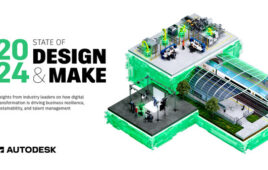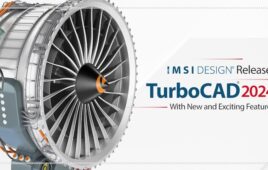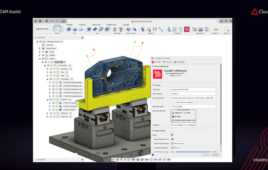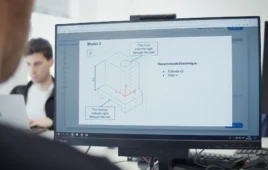Computer-based simulation software has been around a long time. It’s value in enabling companies to validate designs without costly physically testing has been well documented. Despite the advantages, the technology has had its challenges in terms of widespread adoption. It’s been criticized as being too expensive and too difficult to use.
A recent CIMdata report outlines the reasons preventing more widespread adoption of simulation. According to the report, “The underlying issue is complexity. Many simulation applications are difficult to use, and may require years to develop the appropriate expertise.”
To make simulation software easier to use, several vendors developed simulation packages that were directly integrated with CAD systems. By and large, these CAD-integrated simulation software were also not widely embraced by the industry. Many believe this is due to the fact that not many engineers and product designers–for whom these products were developed–understand the underlying fundamentals of simulation.
In regards to why efforts to embed simulation in the CAD environment has also not been successful, the CIMdata reports says, “democratization is about simplifying the application of the tools and making them more widely available. It is not for these powerful tools to be used by those who do not understand the product and engineering issues.”
MSC takes a different approach to simulation
MSC Software has been in the simulation game for a very long time, over 50 years. Its clients include some of the largest companies in the world that manufacture a wide range of highly complex products ranging from aircraft, rockets and cars to high-tech electronics and appliances. These customers demand best in-class analysis capabilities to help them make critical design improvements so they can get products to market faster in these highly competitive markets.
When the company set about on the task of developing an entirely new approach to simulation back in 2010, it started out by listening to its customer base and learned the following:
* Simulation is too hard to learn and use
* The workflow between designers, engineers and analysts is inefficient
* Cleaning geometry and meshing simply takes too much time
* Simulation results are not received in a timely manner which makes trade studies nearly impossible
* Most engineers would like to perform simulation much earlier in the design process
* Simulation models hardly move through the supply chain
Today, the company announces its MSC Apex, the world first computational parts-based computer-aided engineering (CAE) system, that will serve as a platform for a broad range of physics and applications, which the company will roll out over the next year. What makes Apex unique is it is a fully integrated and generative simulation environment that offers full associativity between geometric and analysis data and radically changes the traditional pre-solve-post workflow commonly used in analysis.
On the performance side, the company reports that Apex’s CAE-specific direct modeling and meshing engine will accelerate the CAD-to-mesh process by a factor of up to 50X. MSC Apex is enabled with integrated solver methods, which allow the user to interactively validate parts and sub-system models, yielding up to a 10X productivity gains in model preparation. Another unique aspect to the Apex platform is that it’s open and extensible for users as well as application partners of MSC.
What exactly is computational parts?
I asked that myself during a recent briefing with the company’s president and CEO, Dominic Gallello. Computational parts (CP) are mathematical models that represent the behavior of a part independently from other parts in an assembly. A CP has a “boundary” where the part can be connected to other parts and “sensors” where you can define key metrics to be recovered. In the case of linear behaviors, many expensive operations can be moved to the CP generation phase saving the computation effort in assembly simulations.
Taking that one step further, a computational assembly has all the same characteristics as a computational part (boundary, sensors and pre-validated physical behaviors) and also contains connectors that are joining the assembled parts.
Advantages of the CP approach to simulation
Computational Parts and Assemblies offer dramatic advantages over the traditional CAD and mesh assembly methodologies. These advantages include:
o Incremental validation – CPs can be independently created and validated rather than waiting to validate parts during the assembly validation phase. In the traditional approach, assemblies take more computational resource to validate and validation is made more difficult because of the complexities introduced when there are many invalid parts in the assembly. Tedious simulation processes are eliminated and overall process time is greatly reduced
o Trade Studies – CPs support the rapid assessment of assembly responses during part conceptual design and during structural layout trade studies. Traditional approaches require the full assembly, solve and recover operations for each design point. CP achieves a significant performance increase for both linear statics and dynamics. Performing rapid “what if” scenarios will help manufactures to no longer have to compromise with acceptable solutions but rather achieve optimum solutions.
o Multi-User – CPs can be exchanged and assembled to share both parts and systems representations in a distributed workflow with teams of individuals involved in creating and analyzing models for parts, subsystems and systems. This can significantly increase a company’s ability to distribute workload, speeding time to market.
o IP protected parts and systems through the supply chain – CPs and assemblies can be exchanged as public (shape, material model and behavior), semi-secret (shape and behavior) or secret parts (behavior only). This can substantially reduce the time it takes for system engineers and part analysts, both within a company and through the supply chain, to achieve a validated design on complex systems.
For more information about MSC Apex, check out the company’s site here.
Filed Under: 3D CAD World




